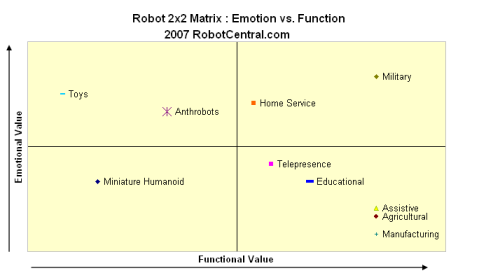Selling products to businesses is a relatively quantifiable endeavor. A business customer calculates the cost of his investment and compares it to his projected increased revenue. If his revenue exceeds his cost then the purchase is deemed to have been worth the investment. The higher and sooner the return, the better the investment. Most of the work in selling to businesses is in determining and negotiating the formula for calculating the return on investment because the currency of a business deal is money.
Such is the case with selling manufacturing robots. Manufacturing robots provide automation. With automation, a business can produce more products more quickly and with consistent quality. Typically, the cost of the investment is overtaken by profit at some point in time.
So where does that leave personal robots? Personal robots represent a new class of robots that are front runners for becoming man’s new partner. What’s that worth? Our findings indicate that robots with no specific function still have a ways to go before consumers will pay for animatronic companionship. Conversely, robots with capabilities that allow us to justify the investment will be quicker to get adopted. Capitalism, it seems, will be the primary driver for adoption of personal robots into society.
Evidence
iRobot stumbled upon human-robot attachment when its home service robot, Roomba, began evoking emotional responses in its owners. A great article by Joel Garreau depicted multiple instances of soldiers bonding with their Military robots in life and death contexts. In the following 2×2 matrix, we’ve plotted the relative position of various classes of robots based on their functional and emotional value.

Robots with higher pure functional value tend to be consumed by businesses. Classes with less function and less emotional value typically fall into the hands of hobbyists who would take issue with the assertion that these robots evoke little emotional attachment.
Projected on the chart is the belief that anthrobots, or humanoid robots, will yield relatively high emotional value with limited functional value. David Levy, a brand new PhD., defended his dissertation on October 11th where he contended that humans and robots will be sharing intimate relationships in the near future. He projected the adoption curve of these robots in the following graph:

Observations like the ones we’ve made about human responses to the child-like robot named CB2 concur with Dr. Levy’s prediction that humans may generally become profoundly disgusted with life-like anthrobots before they’re accepted into mainstream culture.
Military and Home Service robots provide both function and emotional value. Although toys are doing well financially, they don’t offer much function. Their relatively low cost is an investment parents are willing to make. My dad once told me that buying one of his bikes actually meant the purchase of countless smiles and games of cops and robbers for the children of his customers. A child’s happiness, he went on, was neatly packaged on two wheels for $79. That’s a deal.
Two Predictions
- We believe that robots who have both a function and can tap into or facilitate human emotional situations will perform the best. Telepresence robots are first in line because their price point has gone down, mitigating the risk of investment we should realize good performance in Christmas of ’07.
- Competitors in the Home Service robotics sector will emerge in the wake of iRobot’s floor and gutter cleaning robots and have a particularly strong showing Christmas of ’08.
This Time, It’s For Real
Humans have been saying that robot culture is right around the corner for decades. Our observations of trends, and falling prices indicate that this time, it’s really happening.
References:
- Robots Turn Off Senior Citizens in Aging Japan
- Robotics Lab: Robot Types and Applications (Universidad Carlos III de Madrid)
- Robotics Research Group: Types of Robots (University of Texas)
- Formal Study and Military Anecdotes Observe Human-Robot Attachment
- You Might Feel Bad About Turning Off This Robot
- Getting intimate with robots
- Study Finds Human-Robot Attachment
- Sex and Marriage with Robots by 2050
- Bots on the Ground



In the spirit of the McKinsey 2X2, we should name each of the 4 quadrants:
Low EV / Low FV = Hobbyist Quadrant
Low EV / High FV = Industrial Quadrant
High EV / Low FV = Entertainment Quadrant
High EV / High FV = White-Collar Quadrant